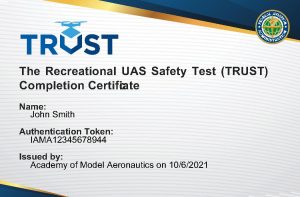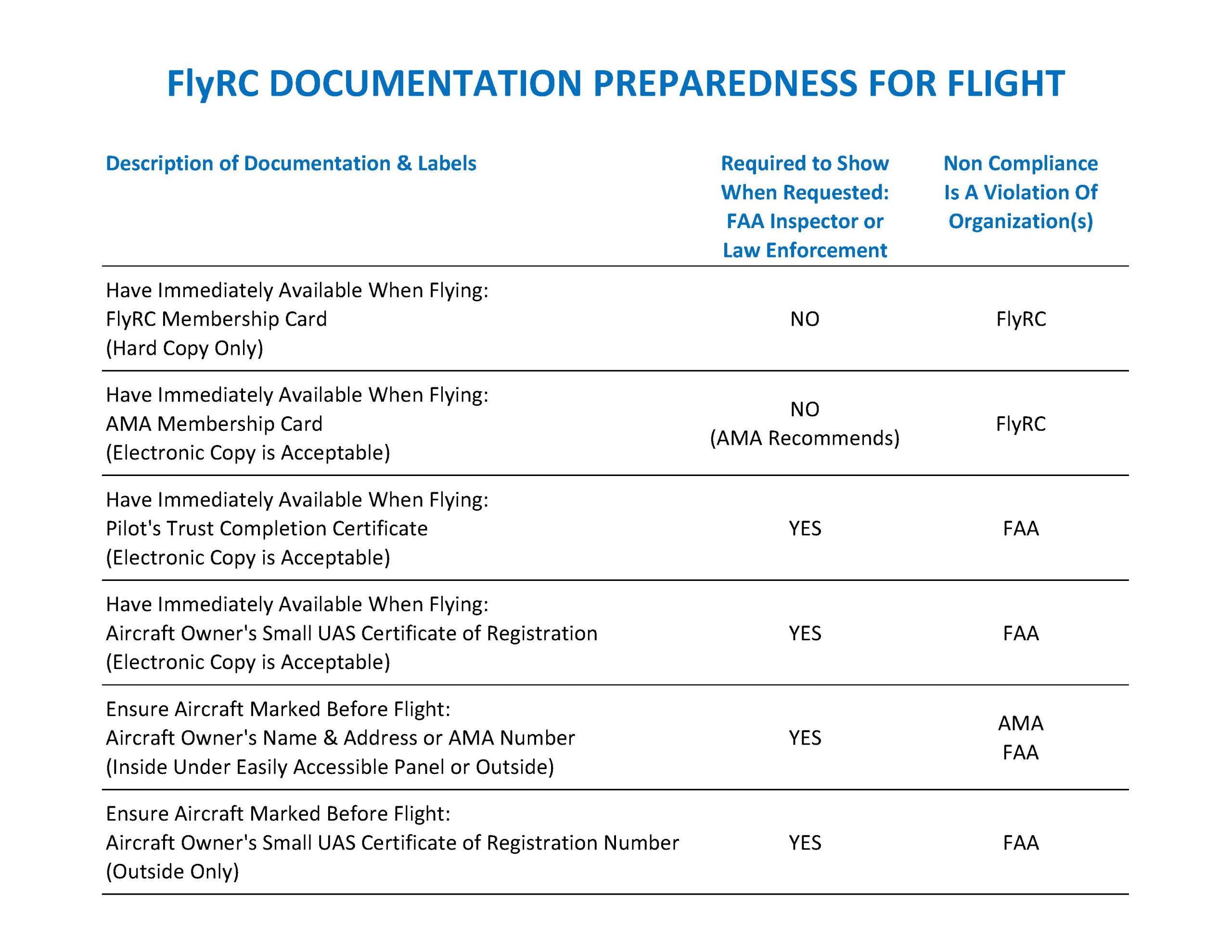Federal Regulations

Current Applicable Regulations
The following are the current Federal Regulations Applicable to fly at the FLYRC field.
The following are the current Federal Regulations Applicable to fly at the FLYRC field.
- All aircraft (drones) must be flown strictly for recreational purposes.
- Remote ID regulations do not apply (FRIA-approved).
- All aircraft must be operated in accordance with the rules and safety guidelines of the Academy of Model Aeronautics (community-based organization).
- Aircraft weighing more than 55 lbs. (including fuel) may be flown only if the unmanned aircraft complies with standards and limitations developed by the AMA.
- All aircraft must be flown within the visual line of sight of the person operating the aircraft or a visual observer co-located and in direct communication with the operator.
- All aircraft must be operated in a manner that does not interfere with and gives way to any manned aircraft.
- All aircraft must be flown from the surface to not more than 400 feet above ground level.
- All pilots and aircraft owners must pass The Recreational UAS Safety Test (TRUST) and must maintain proof of test passage immediately available on paper or in digital format.

- All aircraft owners must obtain a Small UAS Certificate of Registration from the FAA. Pilots must have available at all times a copy of the aircraft owner’s certificate on paper or in digital format.
- All aircraft must be marked with the FAA Small UAS Certificate of Registration ID number of the owner (not the pilot). However, if the pilot is not the owner, the pilot must have a copy of the owner’s Small UAS Certificate of Registration immediately available.
- The FAA Small UAS Registration ID number must be clearly visible on the exterior of every aircraft.
- The aircraft owner’s unique Small UAS Certificate of Registration ID number can be used on multiple aircraft even though only one aircraft requires registration with the FAA for recreational pilots.
- In addition, all aircraft must be marked with either the AMA membership number or the name and address of the owner. This information must be visible either on the exterior of the aircraft or within a compartment that is easily accessible as under a simple hatch that requires no special tools to remove.
- All aircraft weighing 0.55 lbs. (250 grams) or less are not required to meet any of the preceding regulations.
- Aircraft registered as recreational can not also be registered as commercial and visa versa.
Required Documentation
The following documentation must be available upon request by any law enforcement or FAA officer.
The following documentation must be available upon request by any law enforcement or FAA officer.
- AMA membership card
- FAA Small UAS Registration ID of the owner of any aircraft (drone) being flown. The ID number must correspond to the registration number marked on the aircraft.
- TRUST certificate. Evidence of satisfactory completion of The Recreational UAS Safety Test (TRUST) by the pilot (and owner if appropriate).
- FLYRC membership card.
Required Labeling of Aircraft
All aircraft (drones) must be labeled properly to comply with both FAA and AMA requirements.
All aircraft (drones) must be labeled properly to comply with both FAA and AMA requirements.
- The FAA Small UAS Registration ID number of the owner must be clearly marked on the exterior of all aircraft. There is no restriction as to nature or size, but it must be legible.
- All aircraft must be labeled with the owner’s AMA number and/or the owner’s name and address. The label can be visible on either the exterior or the interior of the aircraft. If within the interior, the identification label must be accessible easily without the need for special tools, as under a panel or hatch.
TRUST
All pilots and aircraft (drone) owners must successfully pass The Recreational UAS Safety Test (TRUST).
All pilots and aircraft (drone) owners must successfully pass The Recreational UAS Safety Test (TRUST).
- The Recreational UAS Safety Test is available at the websites of over a dozen different test administrators, including the AMA.
- The test is free and requires no preparation.
- There is no age restriction to take the TRUST exam.
- At the successful completion of the test, a certificate is provided which must be printed and carried when flying. In the alternative, the certificate can be maintained in digital format.

FAA Registration
The FAA requires that all owners of radio-controlled aircraft/drones, that share the national airspace, complete a formal registration process.
The FAA requires that all owners of radio-controlled aircraft/drones, that share the national airspace, complete a formal registration process.
- First, all recreational aircraft (drone) owners must successfully complete The Recreational UAS Safety Test (TRUST).
- Second, the FAA requires that all owners of radio-controlled aircraft obtain a Small UAS Certificate of Registration.

- The registration ID number assigned must be placed on the exterior of all recreational aircraft.
- For recreational pilots, the registration process requires that only one aircraft be registered with the FAA, but the owner’s unique registration ID number must be placed on all aircraft.
- Aircraft owners must be at least 13 years of age, and either a US citizen or a legal permanent resident to apply for an FAA Small UAS Certificate of Registration.
- All aircraft must be also be labeled with the owner’s AMA number and/or the owner’s name and address. The label can be visible on either the exterior or the interior of the aircraft. If within the interior, the identification label must be accessible easily with the need for special tools, as under a panel or hatch.
Remote ID
The most dramatic change in the federal oversight of radio-controlled flight was the implementation of the Remote ID requirement that finally went into effect on March 16, 2024.
The most dramatic change in the federal oversight of radio-controlled flight was the implementation of the Remote ID requirement that finally went into effect on March 16, 2024.
- Remote ID is the ability of an aircraft (drone) in flight to provide identification and location information that can be received by other parties through a broadcast signal. That information includes altitude, velocity, and location, as well as the location and altitude of the controller.
- The FAA has defined discrete FAA-Recognized Identification Areas (FRIAs), that are geographic zones where aircraft can be flown without Remote ID equipment. Both the aircraft and the pilot must be located within the FRIA’s boundaries throughout the operation. In addition, the pilot of the aircraft must be able to see it at all times throughout the duration of the flight.
- 14 CFR Part 89 (Remote Identification of Unmanned Aircraft) requires all pilots of unmanned aircraft to comply in one of three ways to avoid severe fines: operate aircraft with standard integrated Remote ID, attach a Remote ID module to all legacy aircraft, or fly only within certain pre-approved sites.
- All commercially-available drone manufacturers are required to include Remote-ID capability in all products weighing 250 grams (0.55 lbs) or more and produced after September 16, 2023. This requirement does not apply to airplanes and/or helicopters.
- Remote ID modules are available commercially that can be attached to aircraft to provide Remote ID capability for aircraft that do not already have that capability built in.
- All Remote ID serial numbers utilized in aircraft shall be registered with the FAA under the aircraft owner’s Small UAS Certificate of Registration via the FAA website https://faadronezone-access.faa.gov/#/.
- Recreational pilots flying at certain pre-approved sites (FRIA-Approved) do not need to comply with the Remote ID requirement.
- Warning: All recreational pilots must provide Remote-ID capability when flying at a location that is not FRIA-Approved.
FRIA
The Academy of Model Aeronautics (AMA) has succeeded in protecting AMA pilots at AMA sites from the requirements of Remote ID.
The Academy of Model Aeronautics (AMA) has succeeded in protecting AMA pilots at AMA sites from the requirements of Remote ID.
- FAA-Recognized Identification Areas (FRIAs) are specific geographic locations recognized and approved by the FAA where aircraft (drones) can be flown without Remote ID equipment.
- Both the aircraft and the pilot must be located within the FRIA’s boundaries throughout the operation.
- The pilot of the aircraft must be able to see it at all times throughout the duration of the flight.
- UASidekick.com is an excellent website and app that allows easy identification and location of FRIA-approved sites.
- The FLYRC field in Southbury, CT is a FRIA-approved site.
- Warning: All recreational pilots must provide Remote-ID capability when flying at a location that is not FRIA-Approved.
Pilots of Age Less than 13 Years
- There is no minimum age to fly a recreational unmanned aircraft (drone).
- Currently, the minimum age to obtain an FAA Small UAS Certificate of Registration is 13 years. Therefore, a minor under the age of 13 must fly under the registration of an aircraft owned by an individual who meets the Small UAS Certificate of Registration requirements.
- FAA registration is only available to US citizens and legal permanent residents.
- There is no minimum age to take The Recreational UAS Safety Test (TRUST).
United States Regulatory Organization
The laws and regulations of the United States are published in two separate volumes: the United States Code and the Code of Federal Regulations.
The laws and regulations of the United States are published in two separate volumes: the United States Code and the Code of Federal Regulations.
- The United States Code (USC) is made up of the official federal statutes of the United States. It includes laws passed by Congress, also called statutes. The USC is divided into Titles, Subtitles, Chapters, Subchapters, Parts, Sections, and Paragraphs, but not necessarily in that order.
- USC Title 49 (Transportation), Subtitle VII (Aviation Programs), Part A (Air Commerce and Safety), Subpart III (Safety), Chapter 448 (Unmanned Aircraft Systems) contains Section 44809 (Exception for Limited Recreational Operations of Unmanned Aircraft). 49 USC §44809 describes the federal requirements governing use of recreational unmanned aircraft. Those are the requirements to which we at FLYRC must adhere. Therefore, recreational UAS pilots are said to operate under UAS Section 44809.
- The Code of Federal Regulations (CFR) contains all of the regulations published by the 15 agencies of the executive branch of government. Simply put, nearly all entries in the Code of Federal Regulations are basic repetitions of the matching United States Code as it applies to the agency responsible for compliance with that Title and/or Section of the United States Code.
- Title 14 of the CFR is called “Aeronautics and Space.” Part 107 of Title 14 provides the regulations governing the use of “Small Unmanned Aircraft Systems,” but is generally relevant only to licensed, commercial drone pilots or pilots of UASs who wish to fly in populated areas or at night. Such pilots must take a formal certification examination at an accredited testing facility. They seek to fly over “human beings” (populated areas) and at night, and to charge for their services. They are said to operate under “Part 107.” However, Title 14 contains an explicit exception for recreational Unmanned Aircraft Systems (UAS) pilots. Interestingly, as yet that exception appears in Title 49, Part 448 of the USC, not the CFR. One must presume that the FAA will add the provisions of the recreational exception to the CFR eventually.
- The USC and the CFR are closely related and easily confused since they often use the same terminology. For example, the USC and the CFR are each divided into Titles, but most relevant to our hobby are the Federal Aviation Agency (FAA) regulations, which ultimately govern the use of airspace by radio-controlled airplanes, helicopters, and drones. Those FAA regulations are published in the Code of Federal Regulations and are updated frequently.


